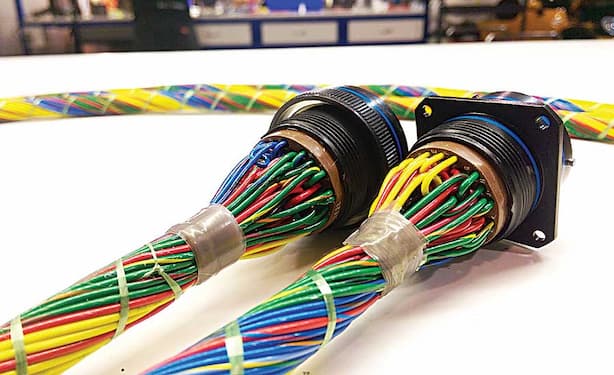Car Electrical Systems: The Role of Wiring Looms in Ensuring Safety and Reliability
Cars are getting more complex, and include dozens of safety and comfort extras, even in lower trims. This means more wiring so that lane-departure warnings, three-zone climate control, and emergency braking all work as they should. The wiring in those systems also needs to be shielded from common issues like heat and oil from hot engine parts, increasing vibrations on bad roads, and moisture in wet and humid weather.
Protecting wires, cables and wire harnesses is done in different ways. They can be bundled together with zip ties to prevent them from unravelling, but this does little to protect them from external factors. Heat shrink adequately shields wires and cables from heat sources and high temperatures, as well as oil, coolant, water and chemicals. But they’re hard and slow to get right, so not ideal for high volumes, like mass-produced harnesses. Conduits are another alternative, but lack the flexibility for routing in tighter spots. They’ll also add unwanted weight, which can impact key performance factors like acceleration and fuel use.
A recent solution to your wiring woes is tape or wire loom. This is flexible, lightweight, easy to install and most importantly protects existing or new wiring. It’s used in repairs and rebuilds, and for sound-deadening to eliminate noises when cables and harnesses are thrown against panels and other car parts.
Contents
What is Wire Loom Tape?

Whether they’re called wiring harness tapes, wiring cloth or go by branded names, this is a tape with a strong self-adhesive and protective backing material used in protective wrapping, bundling and sealing individual wires, cables and wires arranged in looms. Like the abundance of different names, materials differ too, so there are tapes that protect wire harnesses and looms found in the engine bay and faced with high temperatures and exposure to chemicals, and tapes used to reduce vibrations and excessive noises. The adhesive backing easily sticks to insulation, the tape is easy to tear and apply by hand, and the strong backing provides a lasting and neat-finished result.
Common Tapes Used in Wire Looms and Harnesses
Modern varieties of wire loom tapes can be classified according to the material they’re made of and where they’re used. The most common types are tapes with synthetic rubber adhesive and a PET fabric backing, also called fleece or cloth tape, and tapes with canvas backing and facer materials with high adhesion used for their waterproofing and chemical resistance. Since these line wiring in wet engine bay and underbody vehicle areas, they’re also known as underbody tape.
Fleece tapes get their name from the woolly backer material. They are a simple yet effective solution to wire bundling, general wrapping and connecting uses, and are now common in many OEM applications. The tape exhibits extreme longitudinal strength, meaning it won’t tear along its length, and also has decent elongation without breaking. Much of this is down to the very high tensile strength of 60N/m. Yet, the tape is easy to tear across the grain and simple to apply.
Other favourable properties, like superior noise dampening (reducing noise levels by 6 decibels) and a working temperature range between -40 to 105 Celsius make it ideal for interior and passenger compartment usage. Once on, the strong adhesive keeps looms bundled and protected, but the tape can be removed as easily as it is applied if wires and cables need to be inspected or repaired.
Underbody tapes have higher heat and chemical resistance, making them a durable wiring solution for engine bays and the underbody. Their major selling point though is the ability to wick away water and liquids with ease. They also better deal with general wear, being superior to standard fleece tapes with much higher resistance to abrasions, despite being half the thickness. While the adhesive may not be as strong as fleece types, underbody tapes still stick to bundled wires and looms once on, won’t fray or wrinkle and are also easy to clean. Both tape types are age-resistant, meaning they’ll last for decades.
Tape Alternatives

Conventional alternatives to wire loom tape have been bettered in almost every aspect. Vinyl electrical tape for instance loses adhesion due to temperature changes over time, becomes brittle and doesn’t handle heat too well. It’s also harder to get on, wrinkles easily and doesn’t last as long. It’s also mediocre at most when dealing with liquids and chemicals, and is fairly easy to damage. That’s why it’s been replaced with cloth-based tapes.
Heat shrink tubing has also gone down this path. It takes longer to get on, has less adhesion, and fares worse with vibrations and noise reduction. Moreover, it’s substantially more expensive. Ans you’ll have a harder time replacing it in the event of damage.
Summing Up
Cloth and underbody loom tapes are now the industry standard in bundling wires and wire looms. They have dozens of things going in their favour, including strong adhesion, high resistance to external factors, and simple and quick application. Tapes can also be used in any vehicle part to drone out excessive noise. Pair them with other sound-deadening products, like carpet underlay in car restorations and rebuilds. They shield wiring and electrical components, prevent moisture and heat damage and provide a neat clean appearance. Tapes come in varying widths for a variety of uses and are cheap to buy.






